Page 70 of 878
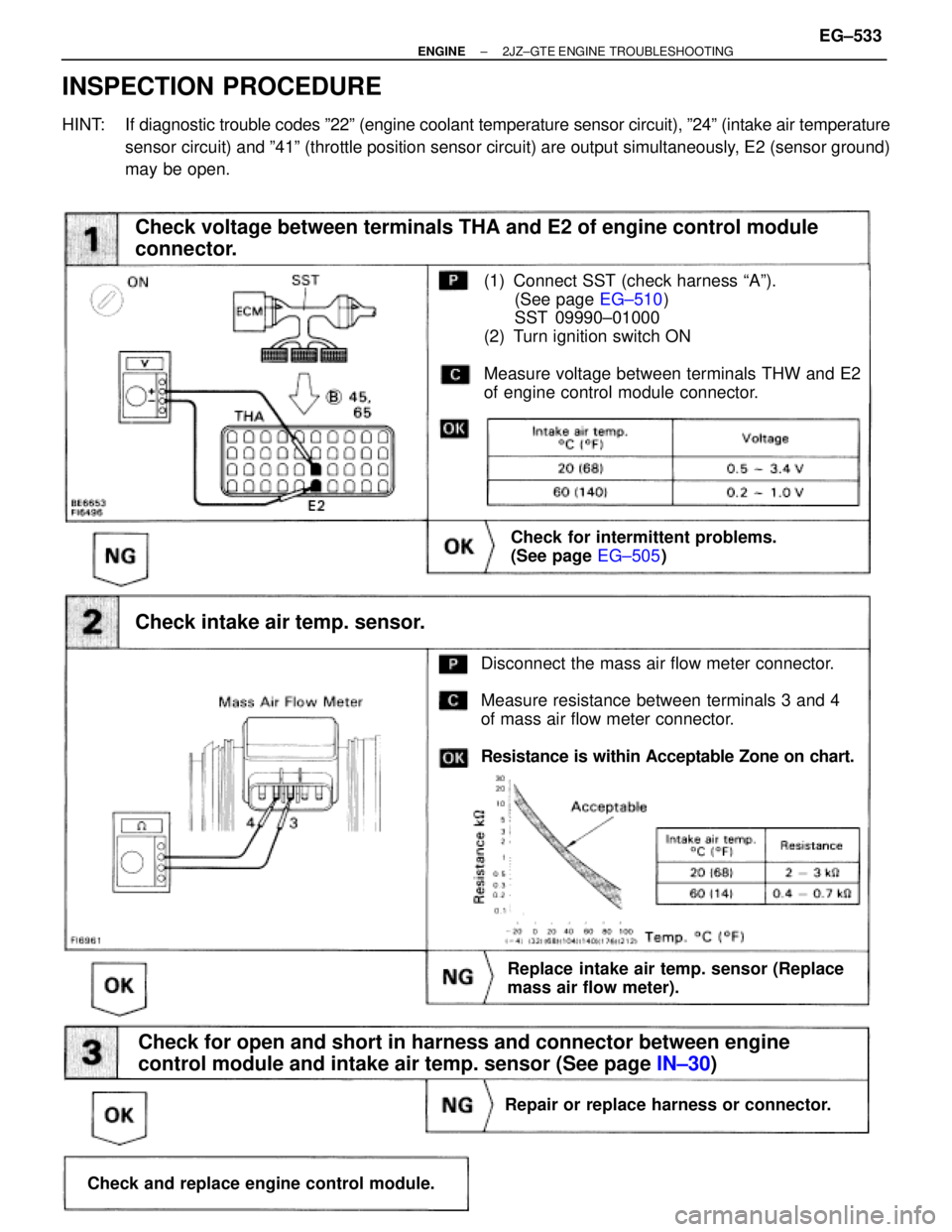
(See page EG±510)
(1) Connect SST (check harness ªAº).
(See page EG±510)
SST 09990±01000
(2) Turn ignition switch ON
Measure voltage between terminals THW and E2
of engine control module connector.
Check voltage between terminals THA and E2 of engine control module
connector.
Check for intermittent problems.
(See page EG±505)
Disconnect the mass air flow meter connector.
Measure resistance between terminals 3 and 4
of mass air flow meter connector.
Resistance is within Acceptable Zone on chart.
Check intake air temp. sensor.
Check for open and short in harness and connector between engine
control module and intake air temp. sensor (See page IN±30)
Replace intake air temp. sensor (Replace
mass air flow meter).
Repair or replace harness or connector.
Check and replace engine control module.
INSPECTION PROCEDURE
HINT: If diagnostic trouble codes º22º (engine coolant temperature sensor circuit), º24º (intake air temperature
sensor circuit) and º41º (throttle position sensor circuit) are output simultaneously, E2 (sensor ground)
may be open.
± ENGINE2JZ±GTE ENGINE TROUBLESHOOTINGEG±533
Page 72 of 878
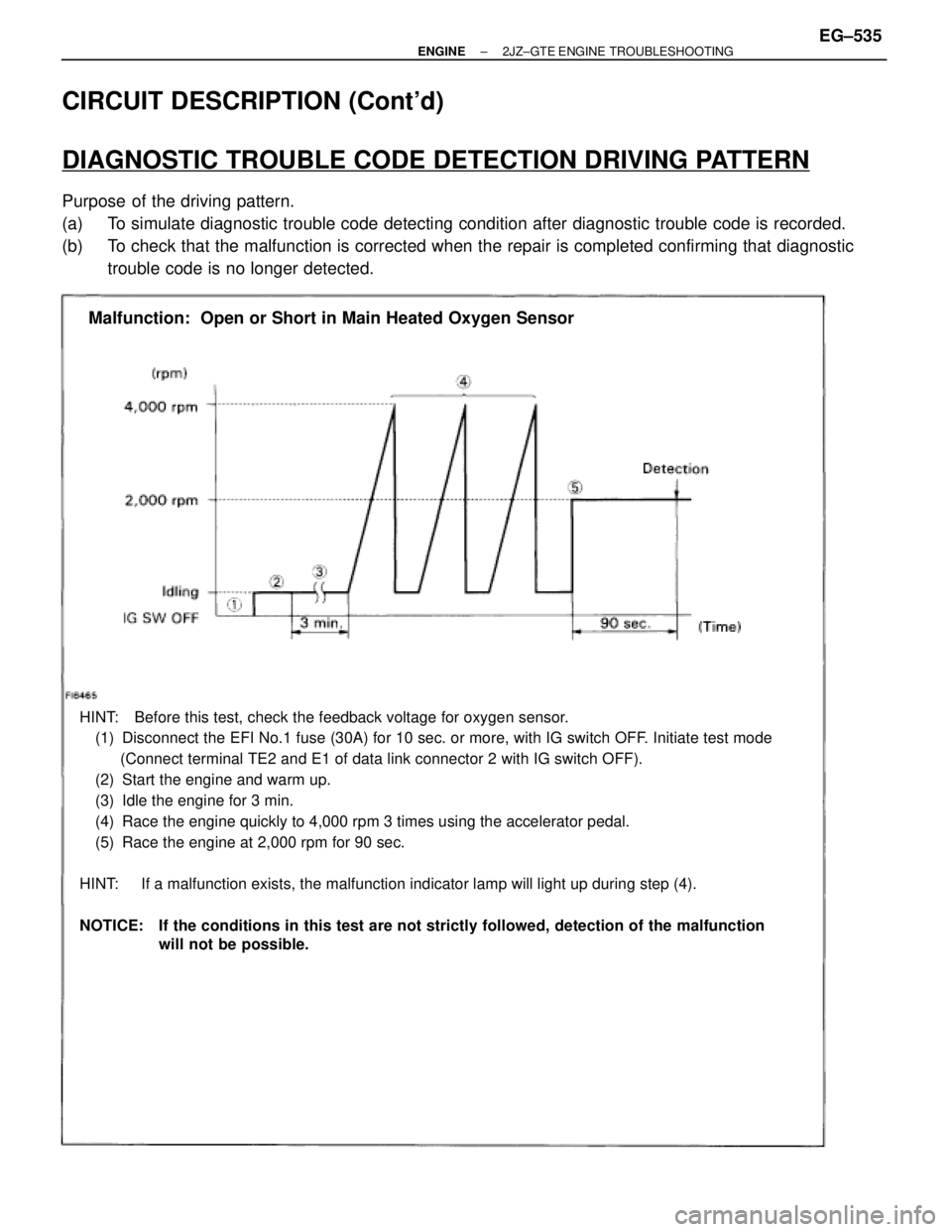
HINT: Before this test, check the feedback voltage for oxygen sensor.
(1) Disconnect the EFI No.1 fuse (30A) for 10 sec. or more, with IG switch OFF. Initiate test mode
(Connect terminal TE2 and E1 of data link connector 2 with IG switch OFF).
(2) Start the engine and warm up.
(3) Idle the engine for 3 min.
(4) Race the engine quickly to 4,000 rpm 3 times using the accelerator pedal.
(5) Race the engine at 2,000 rpm for 90 sec.
HINT: If a malfunction exists, the malfunction indicator lamp will light up during step (4).
NOTICE: If the conditions in this test are not strictly followed, detection of the malfunction
will not be possible.
Malfunction: Open or Short in Main Heated Oxygen Sensor
CIRCUIT DESCRIPTION (Cont'd)
DIAGNOSTIC TROUBLE CODE DETECTION DRIVING PATTERN
Purpose of the driving pattern.
(a) To simulate diagnostic trouble code detecting condition after diagnostic trouble code is recorded.
(b) To check that the malfunction is corrected when the repair is completed confirming that diagnostic
trouble code is no longer detected.
± ENGINE2JZ±GTE ENGINE TROUBLESHOOTINGEG±535
Page 73 of 878
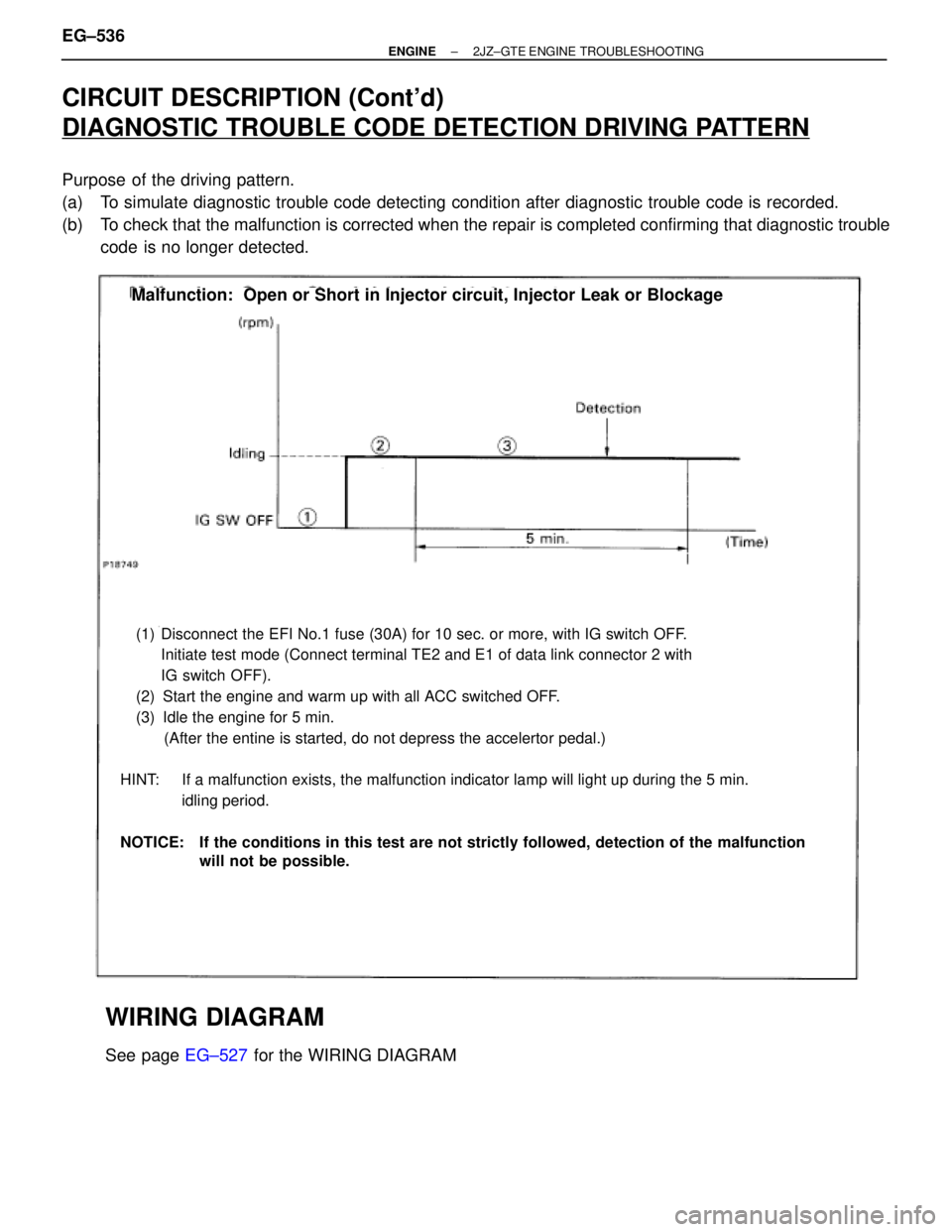
CIRCUIT DESCRIPTION (Cont'd)
DIAGNOSTIC TROUBLE CODE DETECTION DRIVING PATTERN
Purpose of the driving pattern.
(a) To simulate diagnostic trouble code detecting condition after diagnostic trouble code is recorded.
(b) To check that the malfunction is corrected when the repair is completed confirming that diagnostic trouble
code is no longer detected.
(1) Disconnect the EFI No.1 fuse (30A) for 10 sec. or more, with IG switch OFF.
Initiate test mode (Connect terminal TE2 and E1 of data link connector 2 with
IG switch OFF).
(2) Start the engine and warm up with all ACC switched OFF.
(3) Idle the engine for 5 min.
(After the entine is started, do not depress the accelertor pedal.)
HINT: If a malfunction exists, the malfunction indicator lamp will light up during the 5 min.
idling period.
NOTICE: If the conditions in this test are not strictly followed, detection of the malfunction
will not be possible.
Malfunction: Open or Short in Injector circuit, Injector Leak or Blockage
WIRING DIAGRAM
See page EG±527 for the WIRING DIAGRAM EG±536
± ENGINE2JZ±GTE ENGINE TROUBLESHOOTING
Page 74 of 878
INSPECTION PROCEDURE
(1) Warm up engine to normal operating tempera±
ture.
(2) Connect terminals TE1 and E1 of data link
connector 1.
(3) Connect positive probe to terminal VF1 and
negative probe to terminal E1 of data link
connector 1.
(1) warm up the oxygen sensor by racing engine
at 2,500 rpm for about 2 minutes.
(2) Then, still maintaining engine at 2,500 rpm,
count how many times voltmeter fluctuates
need between 0 and 5 V.
Check voltage between terminals VF1 and E1 of data link connector .
Warm up engine to normal operating temperature.
Measure voltage between terminals OX1 and E1
of data link connector 1 when engine is suddenly
raced to full throttle.
The voltage should be 0.5 V or higher at least
once.
Inspection should not take linger than 1 second.
Check voltage between terminals OX1 and E1 data link connector 1.
± ENGINE2JZ±GTE ENGINE TROUBLESHOOTINGEG±537
Page 75 of 878
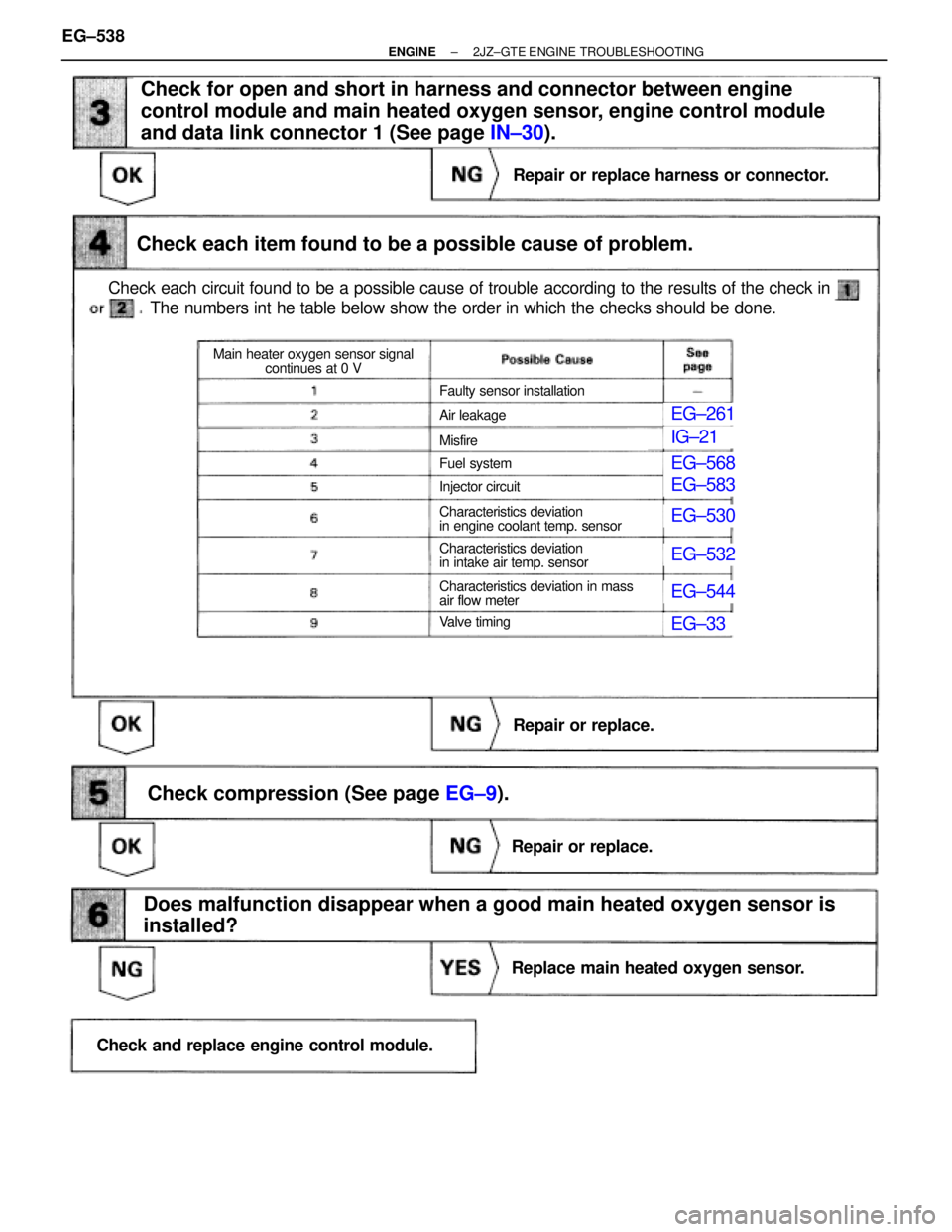
(See page EG±9).
EG±261
IG±21
EG±568
EG±583
EG±530
EG±532
EG±544
EG±33
Check each circuit found to be a possible cause of trouble according to the results of the check in
Check each item found to be a possible cause of problem.
Check for open and short in harness and connector between engine
control module and main heated oxygen sensor, engine control module
and data link connector 1 (See page IN±30).
The numbers int he table below show the order in which the checks should be done.
Repair or replace harness or connector.
Repair or replace.
Replace main heated oxygen sensor.
Repair or replace.
Check and replace engine control module.
Check compression (See page EG±9).
Does malfunction disappear when a good main heated oxygen sensor is
installed?
Faulty sensor installation
Air leakage
Misfire
Fuel system
Injector circuit
Characteristics deviation
in engine coolant temp. sensor
Characteristics deviation
in intake air temp. sensor
Characteristics deviation in mass
air flow meter
Va l v e t i m i n g
Main heater oxygen sensor signal
continues at 0 V
EG±538± ENGINE2JZ±GTE ENGINE TROUBLESHOOTING
Page 76 of 878
EG±583
IG±21
EG±33
EG±261
EG±568
EG±544
EG±530
EG±532
EG±9).
Check each circuit found to be a possible cause of trouble according to the results of the check in
Check each item found to be a possible cause of problem.
The numbers int he table below show the order in which the checks should be done.
Air leakage
Misfire
Fuel system
Injector circuit
Characteristics deviation
in engine coolant temp. sensor
Characteristics deviation
in intake air temp. sensor
Characteristics deviation in mass
air flow meter
Va l v e t i m i n g
Main heater oxygen sensor signal
continues at 5.0 VMain heater oxygen sensor
signal is normal
Check compression (See page EG±9).
Repair or replace.
Repair or replace.
Repair main heated oxygen sensor.
Check and replace engine control module.
Does malfunction disappear when a good main heated oxygen sensor is
installed?
± ENGINE2JZ±GTE ENGINE TROUBLESHOOTINGEG±539
Page 78 of 878
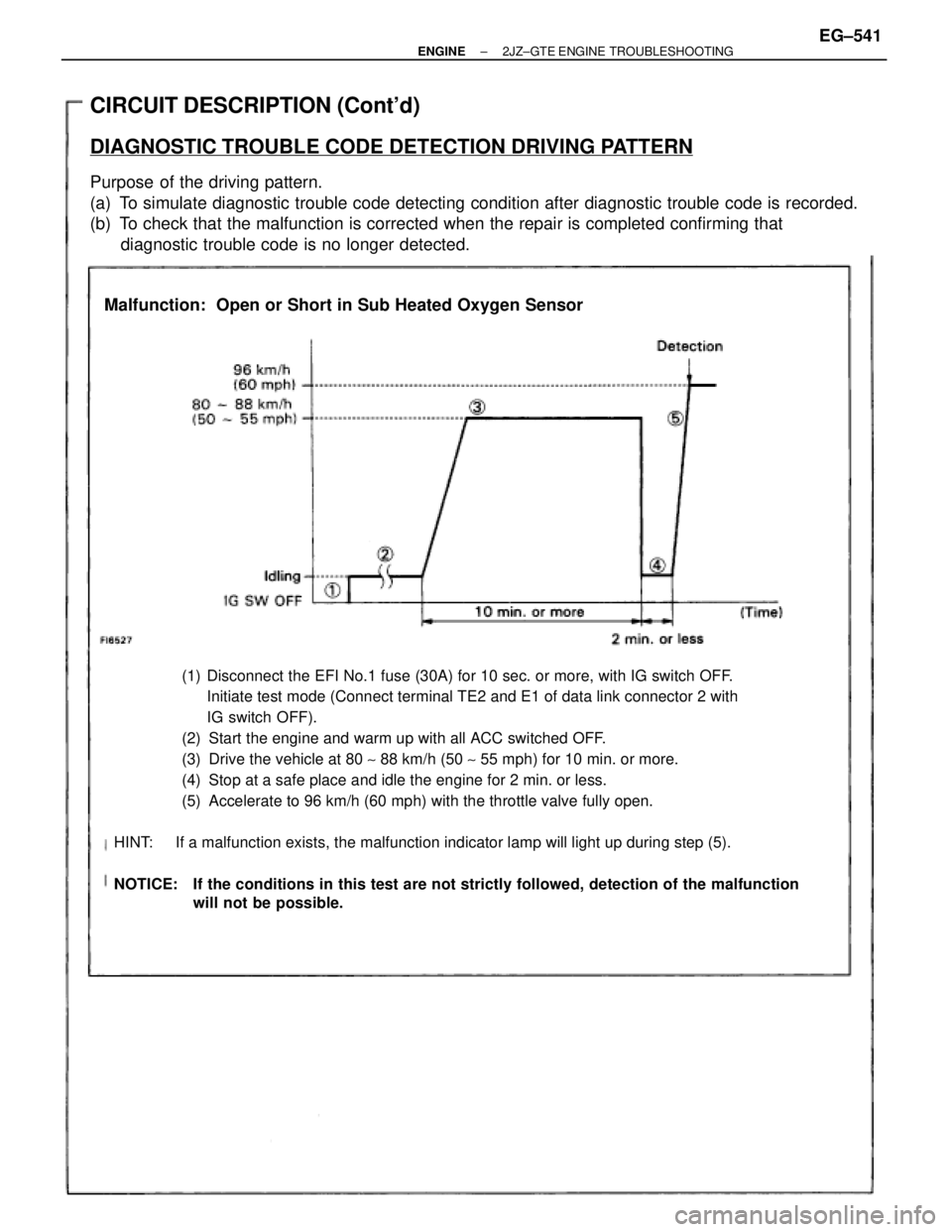
CIRCUIT DESCRIPTION (Cont'd)
DIAGNOSTIC TROUBLE CODE DETECTION DRIVING PATTERN
Purpose of the driving pattern.
(a) To simulate diagnostic trouble code detecting condition after diagnostic trouble code is recorded.
(b) To check that the malfunction is corrected when the repair is completed confirming that
diagnostic trouble code is no longer detected.
(1) Disconnect the EFI No.1 fuse (30A) for 10 sec. or more, with IG switch OFF.
Initiate test mode (Connect terminal TE2 and E1 of data link connector 2 with
IG switch OFF).
(2) Start the engine and warm up with all ACC switched OFF.
(3) Drive the vehicle at 80 ~ 88 km/h (50 ~ 55 mph) for 10 min. or more.
(4) Stop at a safe place and idle the engine for 2 min. or less.
(5) Accelerate to 96 km/h (60 mph) with the throttle valve fully open.
HINT: If a malfunction exists, the malfunction indicator lamp will light up during step (5).
NOTICE: If the conditions in this test are not strictly followed, detection of the malfunction
will not be possible.
Malfunction: Open or Short in Sub Heated Oxygen Sensor
± ENGINE2JZ±GTE ENGINE TROUBLESHOOTINGEG±541
Page 79 of 878
INSPECTION PROCEDURE
HINT: When other codes are output in addition to 27 at the same time, check the circuits for other codes first.
(See page EG±510)
(1) Connect SST (check harness ªAº).
(See page EG±510)
SST 09990±01000
(2) Turn ignition switch ON.
Measure voltage between terminal HT2 of
engine control module connector and body
ground.
Voltage: 9 Ð 14 V
Check voltage between terminal HT2 of engine control module connector
and body ground.
EG±542± ENGINE2JZ±GTE ENGINE TROUBLESHOOTING